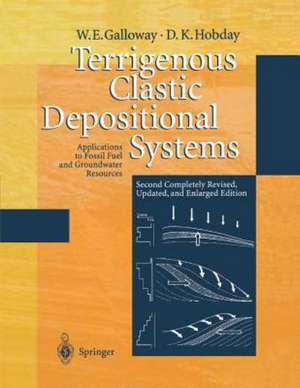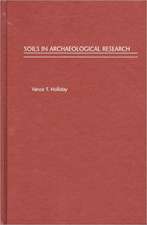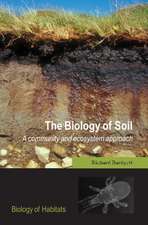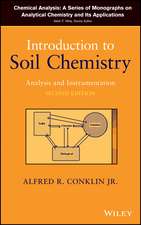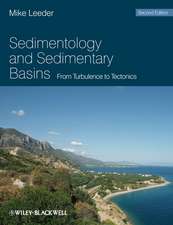Terrigenous Clastic Depositional Systems: Applications to Fossil Fuel and Groundwater Resources
Autor William E. Galloway, David K. Hobdayen Limba Engleză Paperback – 16 noi 2013
Preț: 662.12 lei
Preț vechi: 778.96 lei
-15% Nou
Puncte Express: 993
Preț estimativ în valută:
126.70€ • 135.48$ • 105.64£
126.70€ • 135.48$ • 105.64£
Carte tipărită la comandă
Livrare economică 17 aprilie-01 mai
Preluare comenzi: 021 569.72.76
Specificații
ISBN-13: 9783642646591
ISBN-10: 364264659X
Pagini: 512
Ilustrații: XVI, 491 p.
Dimensiuni: 210 x 279 x 27 mm
Greutate: 1.18 kg
Ediția:2nd ed. 1996. Softcover reprint of the original 2nd ed. 1996
Editura: Springer Berlin, Heidelberg
Colecția Springer
Locul publicării:Berlin, Heidelberg, Germany
ISBN-10: 364264659X
Pagini: 512
Ilustrații: XVI, 491 p.
Dimensiuni: 210 x 279 x 27 mm
Greutate: 1.18 kg
Ediția:2nd ed. 1996. Softcover reprint of the original 2nd ed. 1996
Editura: Springer Berlin, Heidelberg
Colecția Springer
Locul publicării:Berlin, Heidelberg, Germany
Public țintă
GraduateCuprins
1 Fuel-Mineral Resource Base.- Energy Resource Base.- Relevance of Depositional Systems to Energy Resources.- Applications in the Environmental Arena.- 2 Approaches to Genetic Stratigraphic Analysis.- Introduction: Depositional and Sediment Dispersal Systems.- Applied Depositional System Analysis.- Seismic Stratigraphy and Facies Analysis.- Recognition of Depositional Systems: An Example.- Base Level Change and Vertical Sequence.- Integrated Depositional System Analysis.- 3 Alluvial Fans.- Processes Acting on Alluvial Fans.- Spectrum of Alluvial Fan Systems.- Fan Deltas.- Ancient Alluvial Fan and Fan Delta Systems.- Basin-Fill Architecture.- Alluvial Fans Through Geologic Time.- Resource Potential of Alluvial Fan Systems.- 4 Fluvial Systems.- Depositional Processes.- Fluvial Environments and Facies.- Spectrum of Fluvial Depositional Systems.- Eroding Rivers: Stable Channel and Valley-Fill Systems.- Fluvial Evolution Through Geologic Time.- Ancient Fluvial Systems.- 5 Delta Systems.- Delta Process Framework.- Delta Environments and Facies.- Process Classification of Delta Systems.- Fluvial-Dominated Deltas.- Wave-Dominated Deltas.- Tide-Dominated Deltas.- Delta System Recognition.- Delta System Stratigraphic Architecture.- Evolution of Delta Systems.- 6 Shore-Zone Systems.- Spectrum of Shore-Zone Environments.- Shore-Zone Processes.- Shore-Zone Facies.- Shore-Zone Depositional Systems.- Stratigraphy of Shore-Zone Systems.- Shore-Zone Systems Through Geologic Time.- 7 Terrigenous Shelf Systems.- Shelf Processes.- Shelf Sediment Sources and Dispersal Patterns.- Shelf Facies.- Spectrum of Shelf Systems.- Stratigraphic Architecture and Evolution of Shelf Systems.- Shelf Systems in Marine Basin Fills.- 8 Slope and Base-of-Slope Systems.- Slope Processes.- Bedding Architectureof Slope Systems.- Slope Environments and Facies.- Slope System Classification.- Slope Systems in Time and Space.- 9 Lacustrine Systems.- Factors Controlling Lake Geometry and Hydrology.- Stratification of the Water Column.- Lacustrine Environments and Facies.- Lacustrine Sequence Development.- Lake Systems Through Geologic Time.- 10 Eolian Systems.- Supply and Transport of Eolian Sand.- Eolian Bedforms and Structures.- Biogenic Structures.- Dune Types.- Interdune Facie.- Sand Sheets.- Coastal Dune Fields.- Interior Sand Seas (Ergs).- Eolian Sequences.- Associations with Other Depositional Systems.- Hydrocarbons and Minerals in Eolian Systems.- 11 Depositional Systems and Facies Within a Sequence Stratigraphic Framework.- Morphodynamics: Concepts of Regime and Grade Adjustment.- Sequence Stratigraphic Paradigm.- Lessons of the Quaternary — Stratigraphic Signature of High-Frequency, High-Amplitude Sea-Level Change.- Depositional Systems and Sequences: Examples.- Sequences in Other Kinds of Basins.- Integration of Sequences, Systems, and Facies.- 12 Depositional Systems and Basin Hydrology.- Fundamentals of Groundwater Flow.- Properties of the Aquifer Matrix.- Geochemical Properties.- Basin Geohydrology.- Meteoric Flow Regime.- Compactional and Thermobaric Systems.- Hydrology of Depositional Systems.- Example of a Confined Coastal Plain Aquifer System.- Conclusion.- 13 Coal and Coalbed Methane.- Coal Through Geologic Time.- Coal-Forming Depositional Environments.- Coal Petrography and Paleoenvironment.- Coal Rank.- Cyclicity in Peat-Forming Environments and Coal-Bearing Strata.- Depositional Systems and Coal.- Geometry and Evolution of Coal Basins.- Coal-Basin Resources.- 14 Sedimentary Uranium.- Uranium Ore Deposits.- Classification of Uranium Deposits.- Applicationsto Resource Evaluation, Exploration, and Development.- 15 Petroleum.- Distribution of Petroleum in Time and Space.- Depositional Systems and Hydrocarbon Exploration and Production.- Distribution of Petroleum in Depositional Systems.- Example: Intracratonic Basin Depositional Systems and Hydrocarbon Occurrence.- Example: Frio Depositional Systems, Northern Gulf Coast Basin.- 16 Facies Characterization of Reservoirs and Aquifers.- Types and Scales of Heterogeneity.- Styles of Heterogeneity.- Depositional Systems, Genetic Facies, and Fluid Flow.- Sequence Stratigraphic Applications to Reservoir and Aquifer Characterization.- Summary.- References.
Recenzii
"I highly recommend this fine book - the authors and publishers are to be congratulated. Adopt it, buy it!" Sedimentary Geology
"...an excellent and very welcome addition that should be on the bookshelf of anyone seriously engaged in energy exploration." - The American Association of Petroleum Geologists Bulletin
"...an excellent and very welcome addition that should be on the bookshelf of anyone seriously engaged in energy exploration." - The American Association of Petroleum Geologists Bulletin
Textul de pe ultima copertă
This second edition of Terrigenous Clastic Depositional Systems bridges the gap between process-related outcrop studies of sedimentary rocks and the three-dimensional subsurface world of the mineral fuel geologist and hydrogeologist. It remains unique in its focus on the application of subsurface facies analysis to problems of petroleum, coal, uranium, and ground water resource discovery, delineation, and production. The text and figures have been rewritten and updated. New chapters summarize applications of sequence stratigraphy to facies analysis and the use of detailed facies interpretation in reservoir and aquifer characterization.
